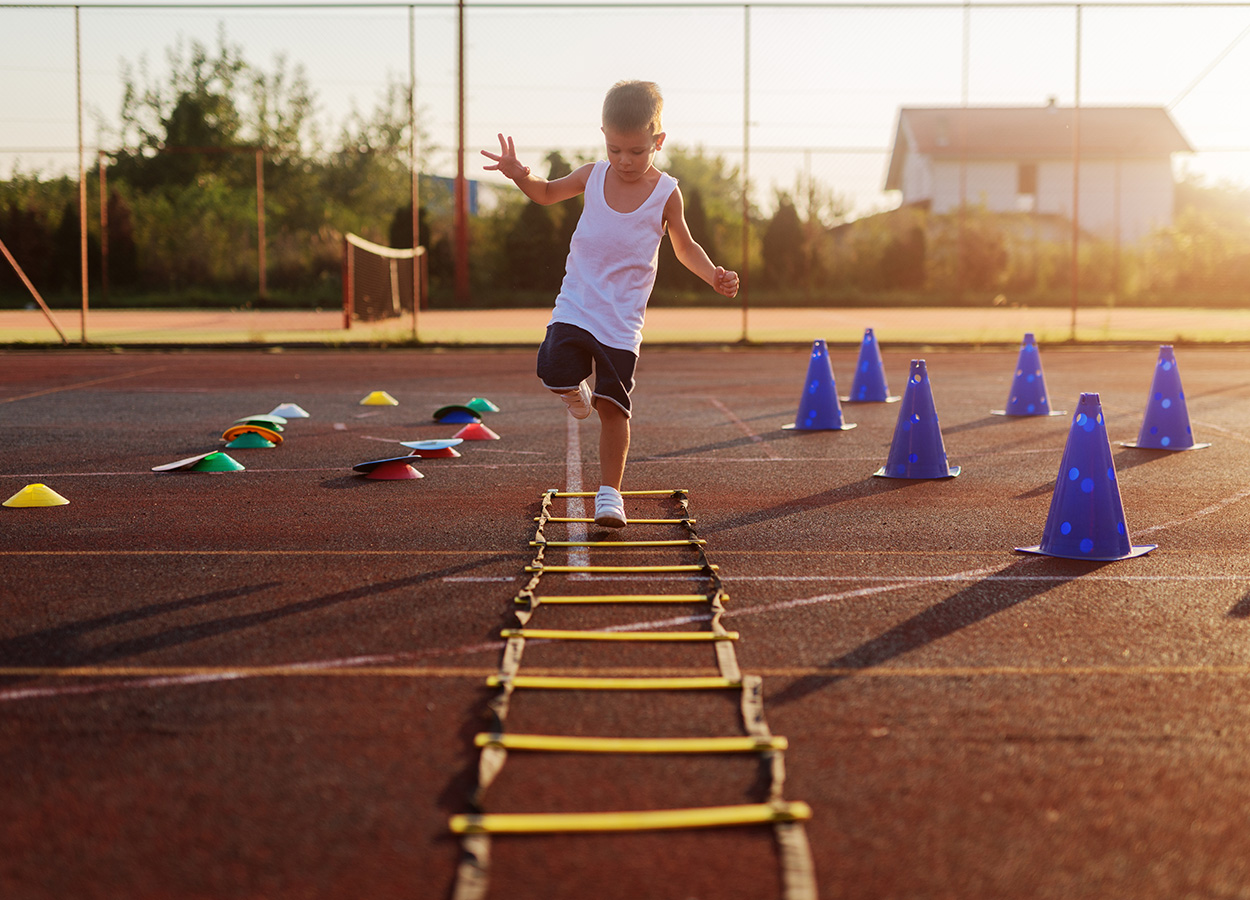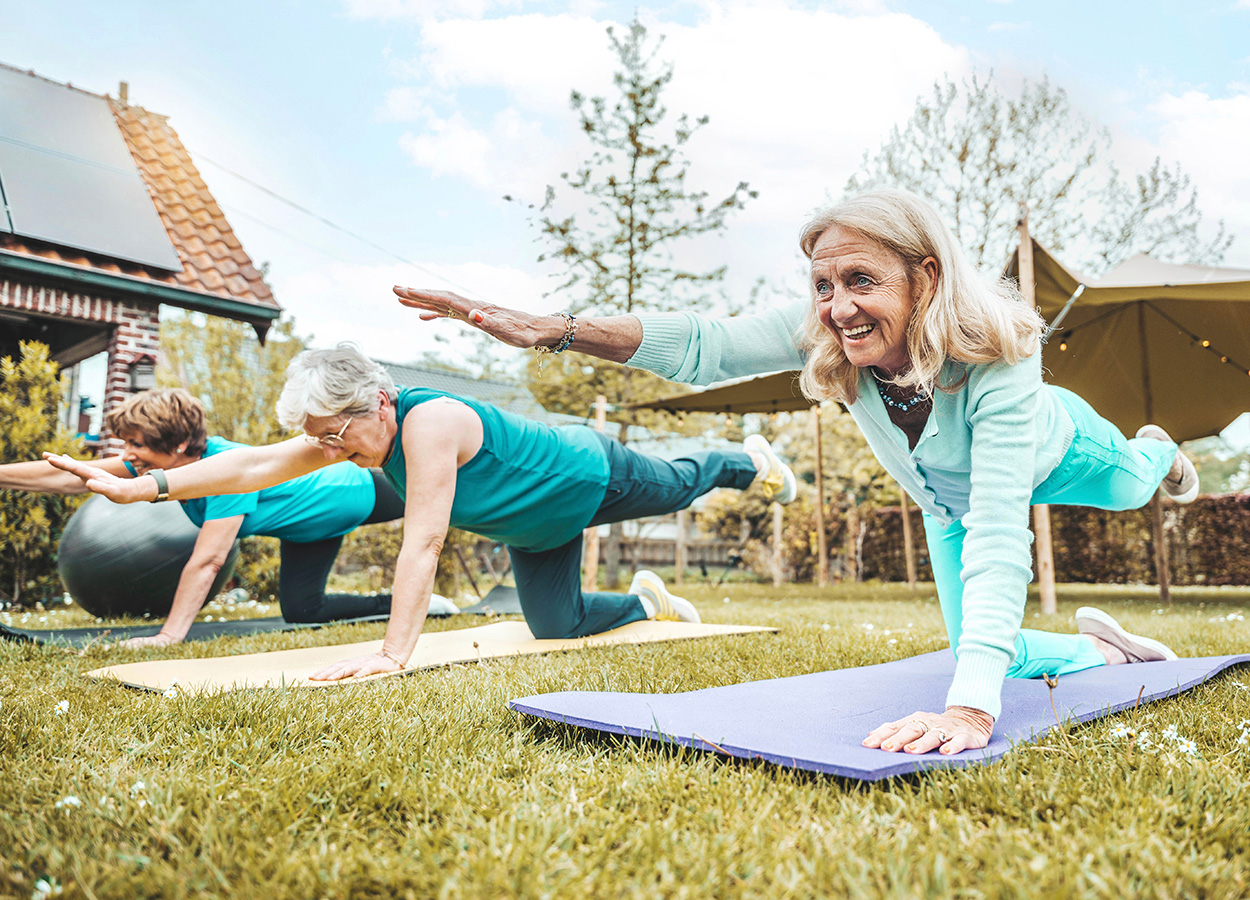Table of Contents |
Skill-related fitness components are mainly related to physical performance, and are relevant to people who want to compete, perform, or train at higher levels beyond everyday health-improving activities. There are six areas of skill-related fitness: power, speed, agility, balance, coordination, and reaction time. However, as we’ll see, some skill-related components overlap with health-related components.
Power is a product of both strength and speed and relates to the rate at which someone can perform physical work or quickly exert muscle force (Corbin et al., 2000). Since speed is a component of power, power-based movements typically are performed at high speeds. Plyometric movements are a type of power movement that involve quick contraction of the muscles to generate high amounts of force, such as in a box jump or a medicine ball slam. Movements that involve speed paired with lifting, throwing, jumping, or quick starts and stops are all methods to improve power (Sipe, 2017).
IN CONTEXT
Research in recent years has made the case for power being considered a health-related component. Building power enhances bone mass, reduces bone fracture risk, and promotes healthy muscle development (Corbin et al., 2017). Power relates to health, and not just skill, as it is associated with higher quality of life as well as reduced risk of disease and early death (Corbin et al., 2022).
Since power is the product of strength (a health-related component) and speed (a skill-related component), it is likely most accurate to consider power as a combined component with overlap into both health-related fitness and skill-related fitness.
Speed is the ability to perform a movement in a short amount of time (Corbin et al., 2000). We might most readily think of track and field athletes doing sprint events like the 100-meter dash, but sports like tennis or baseball also require quick bursts of speed. Movements that focus on health-related fitness components – like running or walking for cardiorespiratory endurance, and resistance training for muscular strength – can be progressed to incorporate speed. A person might choose to start incorporating quick bursts of sprinting or speedwalking in intervals, or they might lift a relatively light load at a higher speed.
Agility relates to the ability to rapidly change body positions in space with speed and accuracy (Corbin et al., 2000). An athlete playing team sports such as football or basketball must have agility to dodge other players or move toward the ball; or surfers and snowboarders need to be responsive to the surface underneath them to stay on the board (DeMet & Wahl-Alexander, 2019).

Balance is the ability to maintain equilibrium, whether stationary, which is termed static balance, or moving, termed dynamic balance (Corbin et al., 2000).
EXAMPLE
Standing on one leg is an example of static balance. While this movement might be useful, it’s typically more relevant to improve balance through dynamic training, which involves maintaining balance while moving (McCall, 2015). Dynamic balance movements are more of what we perform in activities of everyday life, like navigating a curb or walking up stairs. Improving balance can improve walking or running gait, as well as improving your core muscle function, since the core muscles are responsible for helping stabilize you during balance (McCall, 2015).Coordination is the ability to use senses, like sight, along with the body to perform motor tasks smoothly and accurately (Corbin et al., 2000). Coordination may be expressed as hand-eye coordination, like hitting a volleyball, or foot-eye coordination, like dribbling a soccer ball. To execute coordinated movements, an individual needs proprioception, or having a sense of how their body is positioned and moves in space.
Reaction time entails the time elapsed between a stimulus and responding to that stimulus (Corbin et al., 2000). Most contexts of sports require quick reaction, such as a swimmer diving into the pool as soon as they hear the starting gun in a race.
IN CONTEXT
Many skill-related activities have overlap into improving more than one component of skill-related fitness. For example, improving dynamic balance can also boost coordination and agility (McCall, 2015). The benefits of improving these are not just sports-specific but can promote injury prevention in everyday life. For example, if your dynamic balance is good, you will likely also have the proper coordination and agility to avoid falling if you step on an icy patch outside during winter.
Even though the health-related fitness components are arguably more important overall for health than the skill-related components, skill-related components still have importance for some populations and goals.
Children in particular benefit from physical activity that emphasizes both health-related components and skill-related components. Building control of coordination and reaction time can promote confidence in movements, boosting the motivation to continue being active (American Council on Exercise, 2014). Improving skill-related fitness also sets children up to be more successful in a variety of physical activities or sports and is an engaging and fun way to be active (DeMet & Wahl-Alexander, 2019).
Training power and speed can benefit individuals that want to improve their body composition and already have a good foundation of the health-related components of fitness. Movements that focus on speed and power are higher intensity, where high intensity training can have a large calorie burn in a shorter amount of time than slower-paced cardiovascular activity (McCall, 2014a). Speed training also signals the body to release muscle-building hormones and recruits additional types of muscle fibers that can enhance muscle mass and definition (McCall, 2014a).
Older adults can benefit from specific training for balance and coordination. These skills tend to decrease with age, but are important for activities of daily living, like climbing stairs or doing household tasks (Kovar, 2016). Agility, speed, and reaction time are also useful for older adults. Training these skills improves muscle force production and reflexes, which typically reduce with the aging process (McCall, 2014b).

The following are some example movements for each of the skill-related components of fitness. Incorporating skill-related movements should only be done after a thorough warm-up, since they can place more stress on the body (McCall, 2014b). Consulting with a certified fitness professional, such as a personal trainer or strength and conditioning specialist, is the best way to ensure that skill-related fitness training is safe and effective.
| Skill-Related Component | Example Movements |
|---|---|
| Power | Medicine ball slams, broad jumps, vertical jumps, plyometric movements like squat jumps or pushups |
| Speed | Sprinting (including short interval bursts, such as on a bicycle, treadmill, or rower), or faster tempo of resistance training |
| Agility | Agility ladder drills or cone drills |
| Balance | Walking on balance beams, using unstable surfaces such as stability balls |
| Coordination | Juggling, jumping rope, dribbling basketballs |
| Reaction time | Catching, bouncing, and throwing movements with balls |
IN CONTEXT
In 2022, the U.S. Army began implementing new fitness testing for the military, termed the Army Combat Fitness Test (ACFT). This test requires soldiers to perform six tasks (Bigelman et al., 2019):The updated ACFT was a significant change from the previous fitness testing, which had been in place since 1980. The previous test, termed the Army Physical Fitness Test (APFT), required soldiers to complete three tasks – a 2-mile run, 2 minutes of pushups, and 2 minutes of sit-ups (Heinrich et al., 2022). Per the U.S. Army, a main reason for changing the test was because the three tasks in the APFT were not enough to simulate the various real-world demands that a soldier could face in combat. In comparing the two tests, you might observe that the APFT mainly covered only cardiorespiratory endurance and muscular endurance. In contrast, the ACFT covers multiple components of both health-related fitness and skill-related fitness – highlighting the value of combining various components for specific outcomes.
- 3 repetition maximum deadlift
- Standing power throw of a 10 lb. medicine ball for distance
- Maximum amount of hand release pushups in 2 minutes
- Sprint-Drag-Carry using 5 x 50 meter runs and a weighted sled
- Holding a plank for as long as possible
- 2 mile run as fast as possible
Source: THIS TUTORIAL WAS AUTHORED BY Anna Caggiano FOR SOPHIA LEARNING. PLEASE SEE OUR TERMS OF USE.
Disclaimer: The use of any CDC and United States government materials, including any links to the materials on the CDC or government websites, does not imply endorsement by the CDC or the United States government of us, our company, product, facility, service, or enterprise.
REFERENCES
American Council on Exercise (2014). Youth fitness: integrative fitness training. American Council on Exercise. www.acefitness.org/resources/everyone/blog/5061/youth-fitness-integrative-fitness-training/
Bigelman, K. A., East, W. B., Thomas, D. M., Turner, D., & Hertling, M. (2019). The new Army Combat Fitness Test: an opportunity to improve recruitment and retainment. Obesity, 27(11), 1772-1775. doi.org/10.1002/oby.22619
Corbin, C. B., Pangrazi, R. P., & Franks, B. D. (2000). Definitions: Health, fitness, and physical activity. President's Council on Physical Fitness and Sports Research Digest, 3(9). files.eric.ed.gov/fulltext/ED470696.pdf
Corbin, C. B., Janz, K. F., & Baptista, F. (2017). Good health: The power of power. Journal of Physical Education, Recreation & Dance, 88(9), 28-35. doi.org/10.1080/07303084.2017.1367742
Corbin, C.B., Castelli, D.M., Sibley, B.A., and Le Masurier, G.C. (2022). Fitness for Life (7th ed.). Human Kinetics. ISBN: 9781718208704.
DeMet, T., & Wahl-Alexander, Z. (2019). Integrating skill-related components of fitness into physical education. Strategies, 32(5), 10-17. doi.org/10.1080/08924562.2019.1637315
Heinrich, K. M., Streetman, A. E., Kukić, F., Fong, C., Hollerbach, B. S., Goodman, B. D., ... & Poston, W. S. (2022). Baseline physical activity behaviors and relationships with fitness in the army training at high intensity study. Journal of Functional Morphology and Kinesiology, 7(1), 27. doi.org/10.3390/jfmk7010027
Kovar, E. (2016). Coordination exercises for active aging clients. American Council on Exercise. www.acefitness.org/resources/pros/expert-articles/5984/coordination-exercises-for-active-aging-clients/
McCall, P. (2014a). The benefits of speed training for non-athletes. American Council on Exercise. www.acefitness.org/resources/everyone/blog/5030/the-benefits-of-speed-training-for-non-athletes/
McCall, P. (2014b). Benefits of agility training for non-athletes. American Council on Exercise. www.acefitness.org/resources/everyone/blog/5041/benefits-of-agility-training-for-non-athletes/
McCall, P. (2015). Dynamic balance: 5 benefits of training for dynamic balance. American Council on Exercise. www.acefitness.org/resources/everyone/blog/5428/dynamic-balance-5-benefits-of-training-for-dynamic-balance/
Sipe, C. (2017). Stop loading and start exploding: power training for powerful aging. American Council on Exercise. www.acefitness.org/resources/pros/expert-articles/6572/stop-loading-and-start-exploding-power-training-for-powerful-aging/